Earlier, the Moscow region was considered difficult for winegrowers. Cultivars that were resistant to difficult climatic conditions were easy to count on the fingers. Demand creates supply, thanks to the hard work of breeders, now we can choose from many unpretentious varieties the best grape varieties for outdoor cultivation in the suburbs.
Content
Features of the Moscow Region Climate
Spring in the Moscow Region is long, the first half of summer is very hot, and the second is usually rainy. Winters in the region can be windy, moderately frosty or quite severe with stable snow cover. Given the climate, we highlight the main criteria for choosing grapes for the Moscow region:
- the variety must withstand winter frosts up to 20 degrees with short-term drops to 25. Resistance to late spring return frosts is important;
- give preference to varieties with high bush growth and rapid ripening of shoots;
- during the ripening period, increased humidity is extremely undesirable, the fruits crack, rot, and fall off. For the suburbs, early ripe varieties should be selected.
Grape varieties developed specifically for the Moscow Region have good or medium immunity to fungal diseases, a favorable environment for the development of which is increased humidity in warm weather. Despite the stability, preventive treatments should not be abandoned.
We choose grape varieties for Moscow region
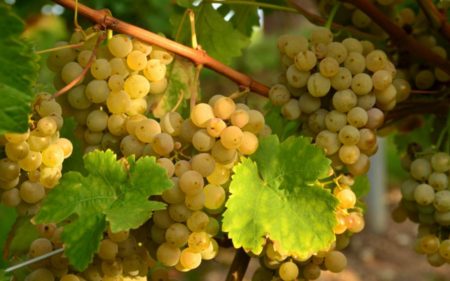
The above criteria for choosing grapes for the Moscow region is the basis. When planting grapes for ourselves, taste, commodity characteristics of brushes and berries are important to us. We divide the varieties according to the use cases, select the most resistant to cold (non-covering) varieties and pay a little attention to decorative grapes.
Varieties that do not require shelter for the winter
To simplify the process of cultivation, winegrowers are looking mainly for non-covering varieties that can be protected only before the bush is fully strengthened. The plant shows all its properties (resistance, immunity) after the start of fruiting.
The maximum minus temperature in the suburbs is 21, rarely 25 degrees, a lot depends on the region. Analyze the weather of your region, take into account 5-6 years, given the lowest rate, proceed to selection, and we will offer you the best non-covering grape varieties for the Moscow region.
| Grade | Description |
| Aleshenkin | The period from budding to maturation takes up to 130 days. The clusters are conical, large, branched from 700 grams to 2.5 kilograms. Oval berries from 3 to 5 grams, amber, sweet and juicy. There are few or no seeds at all. The variety is unpretentious, withstands frosts up to 26 degrees, but requires protection from diseases. Appointment table. Under good conditions, in the third year, you can collect up to 25 kilograms of the crop from the bush. |
| Alpha | Ripening period is medium late (about 150 days). The clusters are cylindrical, medium-sized, dense. The berries are round, medium in size, in technical ripeness bluish-red, when fully ripe, black with a red tint.One bush gives up to 10 kilograms of fruit. The variety tolerates frosts up to 35 degrees without loss, it is resistant to fungi and pests, but it has a weak immunity to chlorosis. |
| Buffalo | A variety of medium early ripening period, in the suburbs of the brush cut off in mid-September. Buffalo grapes can withstand frosts up to 28-30 degrees, not afraid of powdery mildew and gray rot. Brush conical, dense, medium-sized. The berries are dark blue, round-oval, sweet and sour with notes of a forest pear. Buffalo is most often used to make juices and wines. |
| Victoria | 130 days pass from the beginning of flowering to cutting ripe brushes. Victoria tolerates transportation well, withstands frosts up to 26 degrees, is not afraid of diseases, during the ripening period, bushes often attack wasps. Ripe fruits do not crumble for a long time. Bunches from 500 grams to kilograms, loose. The berries are oval 6-7 grams, dark pink. The taste when fully ripened is sweet, rich, nutmeg. |
| Valiant | The period of full ripening falls on the end of August. Frost resistance up to 45 degrees, disease resistance is good. Small brushes, very dense. The berries are small, round (deformed due to the dense arrangement in the brush). The color is blue-black, the skin does not leave the pulp, the bones are large. The taste is very pleasant with a touch of strawberries, sugar content up to 20%, Valiant is used for making wine, but many winegrowers consider it a dining room. |
|
Kuderka
|
The variety is undemanding, unpretentious, tolerates frosts up to 30 degrees. An adult bush in one year gives about 100 kilograms of berries for wine use. Kuderka is ripening closer to the middle or the end of September. The species is not afraid of fungal diseases, but is susceptible to phylloxera. Brush cylindrical or conical not more than 300 grams, the average density. The berries are medium-sized, round, blue-black, juicy and sweet, there are a lot of seeds. When making wine, sugar is not added to the juice, the finished drink has a rich dark cherry color and a slightly tart, very pleasant taste. |
|
Lydia
|
Harvested 155 days after swelling of the kidneys. Lydia is not afraid of lowering the temperature to 26 degrees, tolerates excessive humidity, has good immunity to fungi. The fruits do not crumble for a long time, the better they ripen, the more pleasant their taste will be. Productivity is up to 42 kilograms from one adult bush. Brushes up to 100 grams, loose. The berries are oval-round, dark red or pink-purple. The taste is pleasant sweet with hints of strawberries. |
| Sovering Tiara | Super early variety, fully ripening in mid-August. The bush withstands frosts up to 30 degrees. Productivity is high, the purpose of the table. Brushes up to 200 grams, on the vine are located tightly. The berries are oval-round, white, pleasant, sweet and sour taste. |
| Phenomenon | The ripening period is extended - begins in mid-August, ends in the second half of September. The bush withstands frosts up to 24 degrees. Productivity is high, up to 140 quintals of berries per hectare of land are harvested in industrial vineyards. The clusters are large (from 500 grams to kilograms), conical, rather dense. Table berries, oval, large, white with a yellow tinge. The taste is pleasant, sour-sweet, sugar content up to 22%. |
| Jupiter | The period from the beginning of flowering to harvesting takes only 120 days. Resistance to fungal diseases is good, Jupiter tolerates frosts up to 27 degrees. Universal use (wine, juices, compotes, drying and freezing). 300-500 gram cylindrical or conical brushes, in some cases up to 2 kilograms. The berries are elongated, oval 4-7 grams, in technical ripeness dark red, purple when fully ripened. The taste is sweet with a slightly dull notes of muscat. |
The first 2 years the bush of non-covering grapes is completely hidden.After the beginning of fruiting for the winter, you can leave one sleeve open, and in spring check the result. If the buds have wintered well, the bush is fully grown, and further shelter is no longer necessary.
Table varieties
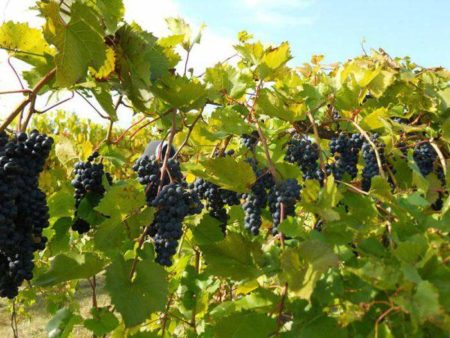
If you are picking grapes for food or for sale take a closer look at the best table varieties, they have beautiful brushes, tasty and seasoned berries. The storage period under the right conditions varies from 2 to 3 months.
| Grade | Description |
| Asma | Brushes up to 400 grams, berries are large, ovoid, dark purple, few seeds (up to 2 seeds in each berry). The pulp is fleshy and juicy, sour-sweet. Asma grapes are transportable and still, the late ripening period is 160 days from flowering to cutting brushes. |
| Agadai | Bunches are large, conical or cylindrical. The berries are large, elongated-oval, emerald with a golden blush from the sun. The pulp is dense, slightly succulent, the taste is ordinary, slightly tart. Seeds are large (3-5 in the berry). It takes 138–160 days from budding to picking berries. Agadai has high transportability and keeping quality. |
| Isabella (late) | Bunches of up to 150 grams, the berries are dark purple, sweet, fragrant. Shelf life of almost 2 months, the berries do not deteriorate and do not lose strawberry flavor. |
| Cardinal | Brushes up to 600 grams, cylindrical, sometimes conical, loose. The berries are juicy, fleshy, large, oval, purple with a reddish tinge. The taste is pleasant with an unobtrusive muscat aroma. From kidney swelling to harvesting, 121 days pass. The variety perfectly tolerates transportation and long-term storage. |
| Beautiful girl | Ripening early. The berries are juicy, fleshy, tasty, dark pink, elongated from 5 to 8 grams, the average mass of brushes is 350 grams. Keeping quality and portability at a high level. |
| Queen of the vineyards | A bunch of up to 450 grams, cylinder-conical, loose. The berries are large, dense, oval, amber with a golden tint. The taste is excellent with a faint muscat aroma. The period from the swelling of the kidneys to the cutting of the hands takes 110 days. With high humidity, the fruits crack and rot. The harvest is not stored for long. |
| Early Magaracha | Ripening early (120 days). Brushes up to 500 grams, conical or wide conical. The berries are oval, large, dark blue, juicy and fleshy with a pleasant taste. Keeping quality and portability low. |
| Odessa early | The clusters are cylindrical-conical up to 300 grams, dense. The berries are not very large, rounded, light green in color with a yellowish tinge. The pulp is juicy, sweet and sour with a nutmeg aroma. 115 days pass from budding to maturation. Odessa early grapes are not transportable enough with average indices of keeping quality. |
| Timur | Harvested after 105-115 days after swelling of the kidneys. Bunches up to 700 grams, cylindrical, moderately loose. Berries of 6-8 grams, oval with a pointed nose, white with a golden tan in the sun. The pulp is dense, tasty with a nutmeg aroma. The rates of keeping quality and portability are high. |
Most often, the berries of the described grape varieties are eaten fresh, without thermal and other processing. But some of them can be used for making wine, various desserts, juices, compotes and assorted fruits and berries.
Technical Varieties
The best wine grapes that can be grown in the suburbs are considered Isabella, Alegot and Muscat, they are demanding to care for, it is not easy to grow them, but your efforts will surely pay off with high yields. There are other equally attractive options.
| Grade | Description |
| Amur | The variety matures in the medium term. Bunches up to 200 grams, cylindrical, dense. The berries are medium-sized, juicy and sweet, rounded, dark blue.Resistance to diseases is increased, bushes withstand frosts up to 40 degrees. |
| Harmony | Conical brushes, medium in size and density. The berries are round, black-blue, juicy, tasty. Fruits ripen 140 days after opening of the kidneys. The bush withstands frosts up to 25 degrees. The wine has a ruby color. |
| Crystal | Brushes cut off 120 days after swelling of the kidneys. Bunches up to 300 grams, cylindrical, loose. The berries are oval, yellow-green, juicy, balanced taste (sugar 18%, acids up to 7 grams per liter of juice). The crystal withstands frosts up to 29 degrees, is resistant to fungal diseases. |
| Marshal Foch | Ripening period is average. The clusters are not large, the berries are small, blue, rounded. Productivity is average. Marshal Foch is attractive to birds. Frost resistance up to 29 degrees, good immunity to fungi. The wine is brightly colored, tasty. |
| Saperavi North | Brushes up to 200 grams, conical with pronounced wings, branched, loose. The berries are small, oval, dark blue, juicy. The juice is thick, raspberry colored. From budding to harvest, 141 days pass. Resistance to fungi is above average. Winter hardiness is excellent, but early opening buds can suffer from return frosts. Young wine can be tart with a grassy flavor. |
Decorative varieties
When designing a recreation area in the country or near the house, an excellent solution would be to plant grapes. Thus, you combine business with pleasure, because this is not about wild grapes, but about edible. Varieties with a beautiful vine, decorative foliage and graceful brushes include Platovsky, Kristall and Saperavi northern.For open ground
All described varieties can be safely planted in open ground. But gardeners, accustomed to cultivating grapes only in the greenhouse, are afraid that in an area with a difficult climate, the variety they like will not take root in the open. We can say with confidence that such varieties as Muscat summer, Victoria, Shunya and Nadezhda Aksayskaya will definitely not fail.
Grape variety ratings for Moscow region
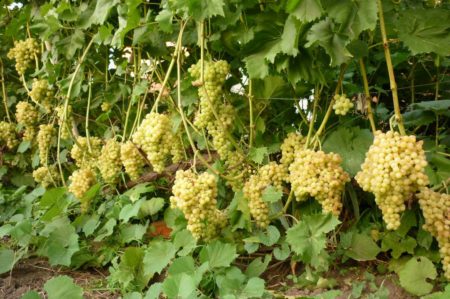
Creating our rating of the best and most reliable grape varieties for the Moscow region, we based on the experience of winegrowers from various areas. We took into account not only the reviews of summer residents, but also reviews of workers in large vineyards located in the region.
| Top 5 best varieties, according to professionals | A selection of amateur winegrowers |
| Victoria | Radiant raisins |
| Aleshenkin or No. 328 | Anniversary of Novocherkassk |
| Laura or Flora | The beauty of the north |
| Nadezhda Aksayskaya | Kristina |
| Super Extra | Tason |
It is better for beginners to rely on the experience of experienced winegrowers, if you can’t find the best option for yourself, be sure to consult sellers in nurseries. In addition to the characteristics of a particular variety, you will receive detailed information about the preferences of the plant and the nuances of growing.
Tips for beginner growers
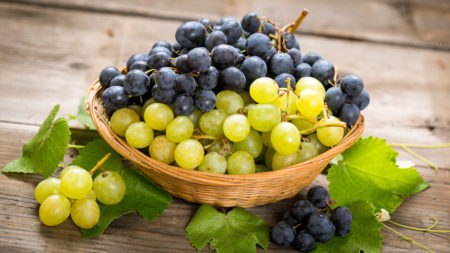
What grape varieties can be planted in the suburbs we found out, now briefly tell you where to plant a bush. We will give some useful recommendations to those who have never once wondered about cultivating a crop:
- grapes need to be planted only in elevated areas or on slopes in places well warmed by the sun. In most areas of the Moscow Region, the location of groundwater is quite high.If you plan to plant a bush in a lowland, build a high bed, organize reliable drainage and water the plant only when absolutely necessary;
- the best soil would be sandy loam, in the spring such soil warms up quickly, and in the autumn it cools down gradually, giving the vineyard the opportunity to prepare well for the winter. Black earth is also suitable;
- be careful with nitrogen-containing fertilizers, and it is better to exclude them altogether. Such top dressing stimulates the growth of the vine, which does not have time to ripen before the onset of frost. There is a risk of partial, and in critical cases, complete freezing of the bush;
- excessively dense growth of shoots of technical grape varieties leads to a decrease in yield and winter hardiness, so they must be crop;
- varieties with poor resistance to frost do not have to be planted in a greenhouse, enough reliable shelter for the winter and protection in dangerous periods (return frosts). Before wintering, the shoots are bent to the ground, covered with garden wrap or dense polyethylene, the edges of the fabric are pressed to the ground with stones, and the canvas is covered with a thick layer of sawdust;
- to increase the immunity of grapes to the climatic conditions of the Moscow region, the bushes are periodically sprayed with Mizorin. It increases resistance to drought, frost, accelerates the ripening process, favorably affects productivity, protects against rot.
Before buying, be sure to look at the forums for the preferences of the selected variety, there you will find recommendations regarding fertilizers, processing and trimming. Subject to the rules of agricultural technology, grow grapes in the suburbs - It's not a problem! Choose the right varieties and enjoy your favorite berry.
Reviews
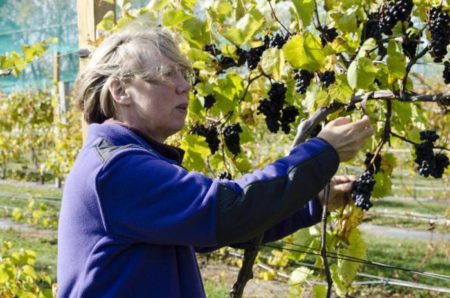
Inna
Planting grapes in the suburbs is a thankless task, there are many troubles, and the yields are weak. So it was before! Now choose, I do not want. My first experience was Jupiter, then Crystal, the third planted the Beauty of the North. Everyone develops perfectly, they are spelled on time, the hands mature completely. I have grown bushes, for the winter I’m not harboring any.
Valery
In the suburbs it is better to plant grapes in the spring (after return frosts) so that the seedling more or less takes root before the fall. I have been growing Saperavi northern for about 9 years, let him go on the gazebo, indescribable beauty. Now I’m just picking up another variety, I’m looking from the canteens. Preventive treatments are mandatory, I do double spraying before flowering, in the middle of summer and after harvesting.

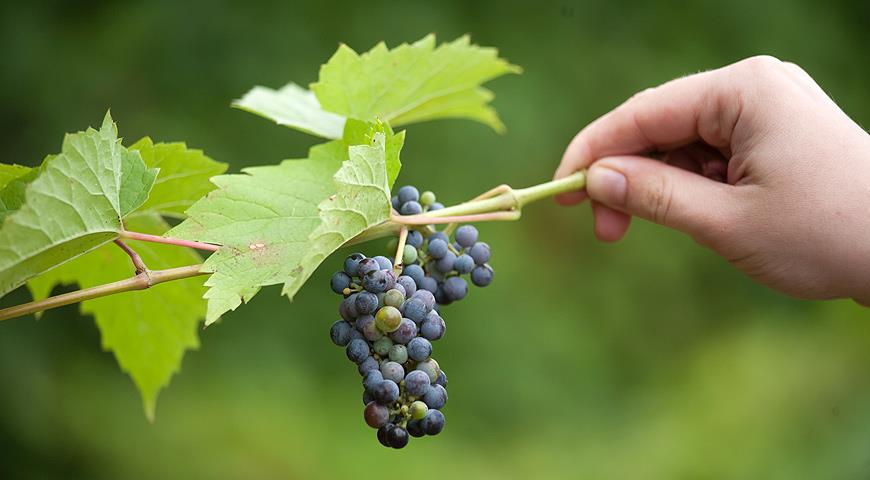



 Non-covering winter-hardy grape varieties for Moscow region
Non-covering winter-hardy grape varieties for Moscow region How to keep the vine in winter
How to keep the vine in winter When can I transfer grapes to another place in the fall
When can I transfer grapes to another place in the fall How to cover and prepare grapes for the winter in the suburbs
How to cover and prepare grapes for the winter in the suburbs